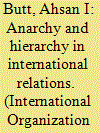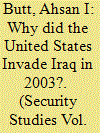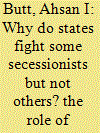|
|
|
Sort Order |
|
|
|
Items / Page
|
|
|
|
|
|
|
| Srl | Item |
| 1 |
ID:
123018


|
|
|
|
|
| Publication |
2013.
|
| Summary/Abstract |
This article questions the validity of anarchy as an assumption in International Relations theory. Powerful states often provide public goods to smaller states in return for their acquiescence on matters of interest. This transactional provision of public goods is analogous to how central governments behave in domestic environments; thus the hierarchic structure of domestic politics is replicated in international politics. The anarchy-hierarchy distinction, which rests on a neat separation of international and domestic structures, is therefore highly contentious. One public good that great powers provide, largely ignored by the literature on hierarchy, is justice. Powerful states can provide a forum for aggrieved parties to settle their disputes, and thus contain conflicts before they escalate to war. If such a forum is no longer provided, the system reverts to anarchy, where escalation-and therefore, war-is more likely. South America's war-prone decade can be explained by the variation in structural conditions on the continent. Due to the Depression, its Good Neighbor policy, and the onset of World War II, the United States was less interested in South American affairs in the 1930s, resulting in a more anarchic structure and a higher propensity for war.
|
|
|
|
|
|
|
|
|
|
|
|
|
|
|
|
| 2 |
ID:
167082


|
|
|
|
|
| Summary/Abstract |
Why did the United States invade Iraq in 2003? Most scholars cite the nonproliferation of weapons of mass destruction (WMD), a neoconservative desire to spread democracy, or the placating of domestic interest groups as the Bush administration’s objectives, but I suggest these arguments are flawed. Instead, I proffer the “performative war” thesis resting on the concepts of status, reputation, and hierarchy to explain the Iraq war. Hegemons desire generalized deterrence, such that others do not challenge their territory, preferences, or rule. However, the challenging of a hegemon’s authority—as occurred on 9/11—generates a need to assert hegemony and demonstrate strength to a global audience. Only fighting a war can demonstrate such strength; no peaceful bargain, even a lopsided one, can achieve the same effect. Consistent with this framework, the United States fought Iraq mainly for its demonstration effect—defeating the recalcitrant Saddam would lead other states to fear the United States and submit to its authority and global order.
|
|
|
|
|
|
|
|
|
|
|
|
|
|
|
|
| 3 |
ID:
156242


|
|
|
|
|
| Summary/Abstract |
Secessionist wars are considered one of the most important sources of violence in international politics. Scholars studying why states adopt coercion or concessions against secessionists have only pointed to domestic factors, such as ethnic heterogeneity or political institutions. By contrast, I argue that state strategy is determined by the external security implications of the secessionist movement. Because secession entails a large and rapid shift in the international balance of power, it generates a commitment problem: Only a state sanguine about future threats can be conciliatory to separatists. Conversely, if the state fears war after border changes, either against the seceded state due to deep identity divisions with the ethnic separatists, or an existing regional adversary due to the war-proneness of its neighborhood, it will adopt coercion. If states choose to coerce, their calibration of violence depends on secessionists’ external support; for materialist and emotional reasons, the more third-party support, the more violent the state. Using data from more than 110 interviews, diplomatic papers, and news archives, I test the theory first by contrasting Czechoslovakia's Velvet Divorce with Israeli intransigence on Palestinian statehood at Oslo, an outcome existing theories would not predict, and then by examining internal variation in India, the country most beset by separatism, across three states in the 1980s: Assam, Punjab, and Jammu and Kashmir.
|
|
|
|
|
|
|
|
|
|
|
|
|
|
|
|
|
|
|
|
|